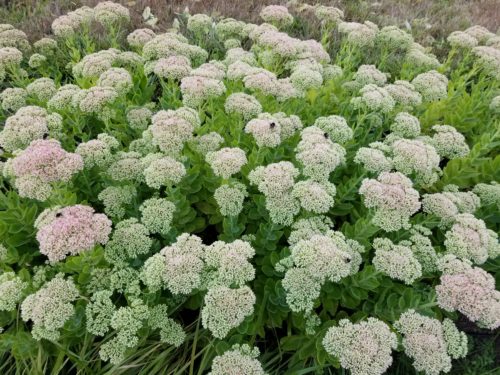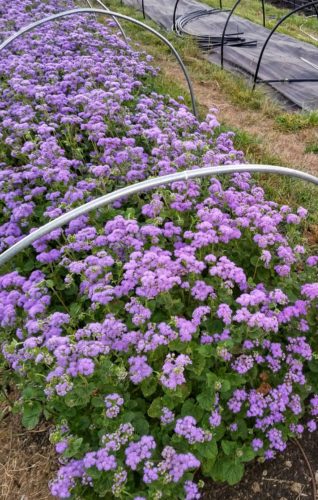Here is a current picture of no till flower farming here on Bare Mtn Farm. Yes, we are still practicing the no till methods. Yes, we are still working on improving our soil. But the most often question we get is, “how do you deal with weeds?”. We have found that the less we work the soil with tilling, broadforking or turning the soil; the less weeds seem to sprout and create a problem. After tarping our rows in occulation, we apply the necessary minerals and a kiss coat(1/2-3/4″) of compost and thoroughly irrigate the row to be planted. Then we plant.
Here is a photo of the close spacing of planted dianthus. We plant many of our flowers at an average spacing of 9×9 on a diamond pattern. This close space planting allows the plants to form a canopy over the soil thus covering up weeds. It also encourages taller flowers as they stretch and muscle for their spot. We typically do one weeding that takes about an hour and half for a 100 ft row. That is usually is good for the row for this succession. We watch the edges of our beds for creeping grass or a low growing weedy vines that are easily removed. Because we have not disturbed the weed bank in the soil for sometime, we are finding as time moves on less weeds are taking root in our rows.
Here is the Amazon Dianthus growing tall and close to shelter the weeds out.
Here is our sedum growing on a fairly close spacing with no weeds in the row. But there is some grass on the edges, that will get scythed and cleaned up.
Ageratum growing in a no-till row with very little weeds. It was planted very close in spacing and weeded once by hand and once with a collinear hoe. You can see a row that is tarped below the ageratum that is in preparation for a fall planted columbines and yarrow.
We also practice no till flower farming in our hoophouses. Here are very closely planted mini blocks of dusty miller planted in one of our hoophouses. We run a length of tarp along the side of the bed that faces outside of the hoophouse, to keep the weeds from creeping in. Weeding this edge is hard with a hoe or by hand so weed suppression is key here.
Same spot and fully grown and harvest-able. No weeds in the row, just tall grass outside the hoophouse.
We feel we are slowly getting the hang of no till methods, improving our soil and getting weeds under pretty good control. That is a good thing because there is a whole host of other problems that need to be dealt with, like insect control and huge critter control. So there is always something new to deal with, learn from and handle.
So we just keeping planting…..









Thanks for documenting this great method of farming. I’m a Landscape Designer and I’ve applied no-till techniques in my two acre Trial and Display Garden since reading Ruth Stouts “No Work Garden Book” over twenty years ago. I recommend it to most of my clients, as it’s an ideal procedure to use with perennials, woody shrubs, and trees in mixed plantings. More recently I’ve used a perennial mulch and raked it away to plant annuals among the perennials and woodies, with good success, (in essence this garden is a giant cutting garden with plants in flower over the longest season possible) at a public garden, Memorial Sunken Garden in Shelbyville, IL. http://www.memorialsunkengarden.org After a couple years, of not tilling the weed seed-bank is reduced dramatically and the perennials have canopied to help reduce weed seeds from sprouting. Instead of tarps we use cardboard covered with mulch for new beds and areas that have become very weedy, reducing the mulch as the plants fill in. The need for access to view and maintain the plantings requires pathways but we prefer mulched pathways because of problems with quack-grass (Elymus repens) and other perennial weeds creeping into the beds from the mown paths. Thanks again for spreading the word about no-till.
This post is SO INCREDIBLY HELPFUL!!! My husband and I are building a brand new cut flower business and our preferred method is no-till. We’ve had a hard time finding info from other FLOWER farmers (plenty of veggie growers), so I wasn’t sure if it was even a good approach for flowers. But this post is a breath of fresh air! Thank you for sharing your wealth of knowledge! I’ve watched every single one of your YouTube videos and we’re big fans : ) Cheers!
Thanks Amy. We intend to keep updating our content on no-till as we progress with using various techniques on the Farm. We have learned so much from the Veggie folks. Be sure to checkout Singing Frogs Farm and Connor Crickmore’s Neversink Farm. Great info on both these farms.
Thanks for this great info! we checked out your website, totally cool!
Thank you very much for sharing your ideas on no till farming. I am currently starting a new plots on a 2 acre fallow land in Yarrow, BC and I am so determined to prepare my beds the way you do it. I have been scouring the internet about starting a flower farm using the no till technique to get that confidence that it is really doable but mostly what’s popping are vegetable farming, until Erin from Floret mentioned about your farm. Being able to watched your videos gave me enough courage to pursue my dream, slowly but sure. Thanks again Bare Mtn Farm!
Thanks so much for your kind words. Hope your Farm journey is a success!
This our second year flower farming with no till in Sebastopol, Ca. Do you have a recommendation for fertilizer that works well with no till. We are using organic practices and used a slow release the first year. I’m not sure that works with drip irrigation.
Thank you for any suggestions.
We have found that fertility requirements are somewhat site specific. Once you have a soil test it will give you a good indication of what minerals or nutrients you need. With us we found that Azomite and cottonseed meal work well as a general boost. Keeping the soil profile moist is the key to letting the biology work on organic amendments. Drip alone in a drier climate doesn’t deliver enough water in the top 1-2 very evenly without some form of a mulch.
What a fantastic way to garden. Thank you for explaining it. It’s discouraging to spend most of my time weeding instead of caring for the flowers themselves.
Hi,
Thanks for the great no-till post on flowers, and most of all, the encouragement. We are getting underway and had strongly felt that no-till would work for us in the same manner it has for vegetables.